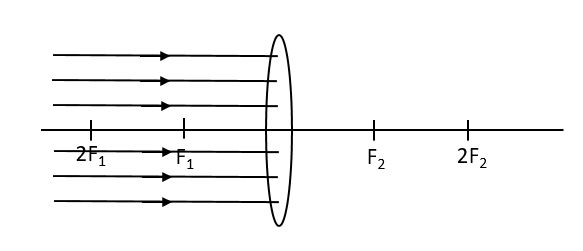10th Grade > Physics
LIGHT - REFLECTION REFRACTION MCQs
:
B
Given, Radius of curvature =10 cm
If the object is placed at infinity the image is formed at the focus.
We know the focal length(F) is half the radius of curvature(R).
F=R2
F=102
⟹ F= 5 cm
So the image of the sun is at 5 cm from the pole.
:
D
Light has dual nature characteristics. It can behave as a particle or a wave depending on the situation. It behaves as a particle in photoelectric effect and as a wave in diffraction.
:
A
The rays of light travelling parallel to the principal axis, after reflection from a concave mirror meet at a single point only if the beam of light is narrow or if the mirror is of small aperture. In case, a wide beam of light falls on a concave mirror of large aperture, the rays after reflection would not converge at a single point. Therefore, if the aperture of the mirror is small, the image formed will be sharper.
:
B
Given:
Object size, ho=4 cm
Object distance, u=−30 cm
Image distance, v=15 cm
Let image size be hi.
Magnification of a lens is given by:
m=vu=hiho
+15−30=hi4
hi=−2 cm
Hence, image height is 2 cm and negative sign shows that the image is inverted.
:
D
Given:
Refractive index of water, μwater = 43
Real depth of fish from surface of water =20 cm
In the given situation,
Refractive Index of water =μwater=Real depthApparent depth
⇒Apparent depth=Real depthμwater
⇒Apparent depth=2043
Therefore, Apparent depth=20×34 = 15 cm. The eagle will perceive the fish to be at 15 cm depth from the water surface.
:
B
Magnification is given by:
Magnification=Height of imageHeight of object
At center of curvature,
Image size equals the object size. Magnitude of magnification is unity.
At focus,
Image size equals infinity. Magnitude of magnification is infinity.
Therefore, it can be concluded that the magnification is increasing.
:
B
Here number of images formed during each occassion is noted and added
Number of images formed = n = (360∘θ − 1)
Total number of images = Number of images when angle between mirrors is at 30°, 60°, 90° and 120°
n = (360∘30∘ − 1) + (360∘60∘ − 1) + (360∘90∘ − 1) + (360∘120∘ − 1)
n = 11 + 5 + 3 + 2 = 21
:
A
The speed of light rays while entering a denser medium from a rarer medium decreases and to reach at the destination in the shortest time (Fermat's principle), it bends towards the normal.


















